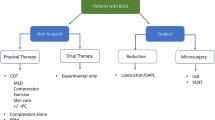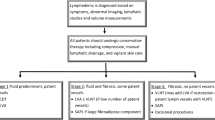Abstract
The evidence available for risk reduction of lymphedema after breast cancer treatment is sparse and inconsistent. It is limited by confounding factors such as axillary disease burden, number of lymph nodes harvested, and radiation treatment. However, there are several strategies for prevention and risk reduction prior to the onset of lymphedema. Techniques such as sentinel lymph node biopsy, axillary reverse mapping, lymphatic anastomosis, and lymphovenular anastomosis are aimed at preventing or minimizing the disruption of lymphatic flow from the upper extremity. Few surgical procedures, such as the historical Charles procedure, as well as newer techniques including distal lymphaticovenular anastomosis, lymph node transfer, suction-assisted protein lipectomy, and low-level laser therapy exist. Nonsurgical treatments include complete decongestive therapy, pneumatic compression, Kinesio tape, and exercise. These have varying degrees of effectiveness but have limitations in patient compliance or availability of certified therapists.



Similar content being viewed by others
References
Papers of particular interest, published recently, have been highlighted as: • Of importance
Schrenk P, Rieger R, Shamiyeh A, et al. Morbidity following sentinel lymph node biopsy versus axillary lymph node dissection for patients with breast carcinoma. Cancer. 2000;88:608–14.
Haid A, Kuehn T, Konstantiniuk P, Köberle-Wührer R, Knauer M, Kreienberg R, et al. Shoulder-arm morbidity following axillary dissection and sentinel node only biopsy for breast cancer. Eur J Surg Oncol. 2002;28(7):705–10.
Swenson KK, Nissen MJ, Ceronsky C, Swenson L, Lee MW, Tuttle TM. Comparison of side effects between sentinel lymph node and axillary lymph node dissection for breast cancer. Ann Surg Oncol. 2002;9(8):745–53.
Blanchard DK, Donohue JH, Reynolds C, et al. Relapse and morbidity in patients undergoing sentinel lymph node biopsy alone or with axillary dissection for breast cancer. Arch Surg. 2003;138:482–8.
Schijven MP, Vingerhoets AJ, Rutten HJ, et al. Comparison of morbidity between axillary lymph node dissection and sentinel node biopsy. Eur J Surg Oncol. 2003;29:341–50.
Ronka R, von Smitten K, Tasmuth, et al. One-year morbidity after sentinel node biopsy and breast surgery. Breast. 2005;14:28–36.
Leidenius M, Leivonen M, Vironen J, von Smitten K. The consequences of long-time arm morbidity in node-negative breast cancer patients with sentinel node biopsy or axillary clearance. J Surg Oncol. 2005;92(1):23–31.
Mansel R, Fallowfield L, Kissin M. Randomized multicenter trial of sentinel node biopsy versus standard axillary treatment in operable breast cancer. The ALMANAC Trial: JNCI. 2006;98(9):599–609.
Lucci A, McCall LM, Beitsch PD, et al. Surgical complications associated with sentinel lymph node dissection (SLND) plus axillary lymph node dissection compared with SLND alone in the American College of Surgeons Oncology Group Trial Z0011. J Clin Oncol. 2007;25:3657–63.
McLaughlin SA, Wright MJ, Morris KT, et al. Prevalence of lymphedema in women with breast cancer 5 years after sentinel lymph node biopsy or axillary dissection: objective measurements. J Clin Oncol. 2008;26(32):5213–9.
Ashikaga T, Krag DN, Land SR, et al. Morbidity results from the NSABP-B32 trial comparing sentinel lymph node dissection versus axillary dissection. J Surg Oncol. 2010;102:111–18.
Wernicke AG, Goodman RL, Turner BC, et al. A 10-year follow-up of treatment outcomes in patients with early stage breast cancer and clinically negative axillary nodes treated with tangential breast irradiation following sentinel lymph node dissection or axillary clearance. Breast Cancer Res Treat. 2011;125(3):893–902.
Giuliano AE1, Hunt KK, Ballman KV, Beitsch PD, Whitworth PW, Blumencranz PW, et al. Axillary dissection vs no axillary dissection in women with invasive breast cancer and sentinel node metastasis: a randomized clinical trial. JAMA. 2011;305(6):569–75.
Passik SD, McDonald MV. Psychosocial aspects of upper extremity lymphedema in women treated for breast carcinoma. Cancer. 1998;83:2817–20.
Tobin MB, Lacey HJ, Meyer L, Mortimer PS. The psychosocial morbidity of breast cancer-related arm swelling. Psychological morbidity of lymphedema. Cancer. 1993;72:3248–52.
Rowland JH, Hewitt M, Ganz PA. Cancer survivorship: a new challenge in delivering quality cancer care. J Clin Oncol. 2006;24(32):5101–4.
Foldi M. Remarks concerning the consensus document (CD) of the International Society of Lymphology “The diagnosis and treatment of peripheral lymphedema”. Lymphology. 2004;37(4):168–73.
Thompson M, Korourian S, Henry-Tillman RS, Adkins L, Mumford S, Westbrook K, et al. ARM (axillary reverse mapping): a new concept to identify and enhance lymphatic preservation. Ann Surg Oncol. 2007;14(2):84–5.
Boneti C, Korourian S, Bland K, Cox K, Adkins LL, Henry-Tillman RS, et al. Axillary reverse mapping: mapping and preserving arm lymphatics may be important in preventing lymphedema during sentinel lymph node biopsy. J Am Coll Surg. 2008;206(5):1038–42. This article describes the anatomical variations of the lymphatics draining the arm within the axillary boundaries and a way of mapping them and preserving them.
Boneti C, Badgwell B, Robertson Y, Korourian S, Adkins L, Klimberg V. Axillary reverse mapping (ARM): initial results of phase II trial in preventing lymphedema after lymphadenectomy. Minerva Ginecol. 2012;64(5):421–30.
Ivens D et al. Assessment of morbidity from complete axillary dissection. Br J Cancer. 1997;66:136.
Petrek JA, Senie RT, Peters M, et al. Lymphedema in a cohort of breast carcinoma survivors 20 years after diagnosis. Cancer. 2001;92:1368–77.
Silberman AW, McVay C, Dohen JS, et al. Comparative morbidity of axillary lymph node dissection and the sentinel lymph node technique: implications for patients with breast cancer. Ann Surg. 2004;240:1–6.
Nesvold IL, Dahl AA, Løkkevik E, Marit Mengshoel A, Fosså SD. Arm and shoulder morbidity in breast cancer patients after breast-conserving therapy versus mastectomy. Acta Oncol. 2008;47(5):835–42.
Rockson SG. Tissue changes, bioimpedance, and acquired lymphedema. Lymphat Res Biol. 2013;11(4):195.
Hayes SC, Janda M, Cornish B, Battistutta D, Newman B. Lymphedema after breast cancer: incidence, risk factors and effect of upper body. J Clin Oncol. 2008;26:3536–42.
Albert US, Koller M, Kopp I, Lorenz W, Schulz KD, Wagner U. Early self-reported impairments in arm functioning of primary breast cancer patients predict late side effects of axillary lymph node dissection: results from a population-based cohort study. Breast Cancer Res Treat. 2006;100(3):285–92.
Larson D, Weinstein M, Goldberg I, et al. Edema of the arm as a function of the extent of axillary surgery in patients with stage I-II carcinoma of the breast treated with primary radiotherapy. Int J Radiat Oncol Biol Phys. 1986;12:1575–82.
Mittendorf EA, Hunt KK. Lymphatic interrupted: do we really understand the risks and consequences? Ann Surg Oncol. 2009;16(7):1768–70.
Tummel E, Ochoa D, Korourian S, et al. Does axillary reverse mapping prevent lymphedema after lymphadenectomy? Phoenix: Presented at the Society of Surgical Oncology; 2014.
Guthrie D, Gagnon G. The prevention and treatment of postoperative lymphedema of the arm. Ann Surg. 1946;123(5):925–35.
Boccardo F, Casabona F, DeCian F, et al. Lymphatic microsurgical preventing healing approach (LYMPHA) for primary surgical prevention of breast cancer-related lymphedema: over 4 years follow-up. Microsurgery. 2014;34(6):421–4.
Dosher ME, Herman S, Garfein ES. Surgical management of inoperable lymphedema: the re-emergence of abandoned techniques. J Am Coll Surg. 2012;215(2):278–83.
Yamamoto T, Yoshimatsu H, Yamamoto N, et al. Modified lambda-shaped lymphaticovenular anastomosis with supermicrosurgical lymphoplasty technique for a cancer-related lymphedema patient. Microsurgery. 2014;34(4):308–10. This article describes a new technique of microsurgical lymphovenular anastomosis which, in preliminary reports, appears to be moderately successful.
Sapountzis S, Nicoli F, Chilgar R, Ciudad P. Evidence-based analysis of lymph node transfer in postmastectomy upper extremity lymphedema. Arch Plast Surg. 2013;40(4):450–1.
Cormier JN, Rourke L, Crosby M, Chang D, Armer J. The surgical treatment of lymphedema: a systematic review of the contemporary literature. Ann Surg Oncol. 2010;19(2):642–51.
Granzow JW1, Soderberg JM, Kaji AH, Dauphine C. Review of current surgical treatments for lymphedema. Ann Surg Oncol. 2014;21(4):1195–201.
E Lima MT, E Lima JG, de Andrade MF, Bergmann A. Low-level laser therapy in secondary lymphedema after breast cancer: systematic review. Lasers Med Sci. 2014;29(3):1289–95.
Rodrick JR, Poage E, Wanchai A, Stewart BR, Cormier JN, Armer JM. Complementary, alternative, and other non-complete decongestive therapy treatment methods in the management of lymphedema: a systematic search and review. PM R. 2014;6(3):250–74.
Chang CJ, Cormier JN. Lymphedema interventions: exercise. Surg Comp Dev Sem Oncol Nurs. 2013;29(1):28–40.
Lasinski BB, McKillip Thrift K, Squire D, Austin MK, Smith KM, Wanchai A, et al. A systematic review of the evidence for complete decongestive therapy in the treatment of lymphedema from 2004 to 2011. PM R. 2012;4(8):580–601. This article describes in detail the phases of complete decongestive therapy which is considered the most reliable treatment for lymphedema.
Feldman JL, Stout NL, Wanchai A, Stewart BR, Cormier JN, Armer JM. Intermittent pneumatic compression therapy: a systematic review. Lymphology. 2012;45(1):13–25.
Tsai HJ1, Hung HC, Yang JL, Huang CS, Tsauo JY. Could Kinesio tape replace the bandage in decongestive lymphatic therapy for breast-cancer-related lymphedema? A pilot study. Support Care Cancer. 2009;17(11):1353–60.
McLaughlin SA. Lymphedema: separating fact from fiction. Oncology. 2012;26(3):242–9. This article describes some of the commonly held beliefs and recommendations that have no basis in fact.
Kwan ML, Cohn JC, Armer JM, et al. Exercise in patients with lymphedema: a systematic review of the contemporary literature. J Cancer Surviv. 2011;5:320–36.
Clark B, Sitzia J, Harlow W. Incidence and risk of arm oedema following treatment for breast cancer: a three-year follow-up study. Q J Med. 2005;98:343–8.
Compliance with Ethics Guidelines
ᅟ
Conflict of Interest
Daniela Ochoa and V. Suzanne Klimberg declare that they have no conflict of interest.
Human and Animal Rights and Informed Consent
This article does not contain any studies with human or animal subjects performed by any of the authors.
Author information
Authors and Affiliations
Corresponding author
Additional information
This article is part of the Topical Collection on Local-Regional Evaluation and Therapy
Rights and permissions
About this article
Cite this article
Ochoa, D., Klimberg, V.S. Surgical Strategies for Prevention and Treatment of Lymphedema in Breast Cancer Patients. Curr Breast Cancer Rep 7, 1–7 (2015). https://doi.org/10.1007/s12609-014-0172-x
Published:
Issue Date:
DOI: https://doi.org/10.1007/s12609-014-0172-x




